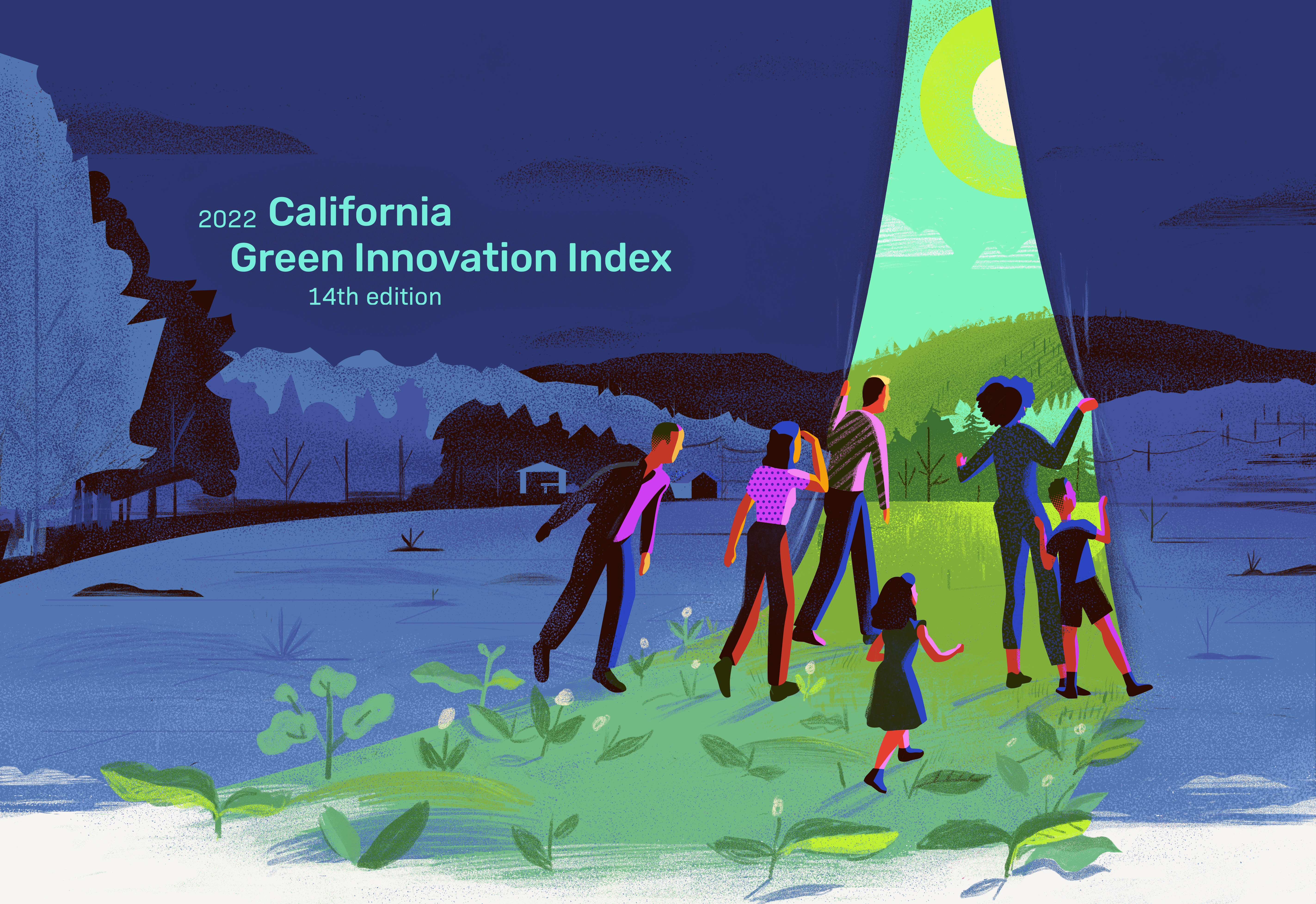Next 10’s California Green Innovation Index tracks the state’s progress in reducing greenhouse gas (GHG) emissions, spurring technological and business innovation, and growing businesses and jobs that enable the transition to a more resource-efficient economy. The 2022 Index is the 14th edition published by Next 10.
California Green Innovation Index
For the second time since Next 10 began producing the Index in 2008, the 14th annual California Green Innovation Index is now primarily digital, allowing readers to learn and interact with the findings of the report in an interactive medium. The report finds total greenhouse gas emissions dropped 8.7 percent between 2019 and 2020, though many of those reductions are a result of COVID-related transportation restrictions and economic disruptions. However, emissions from the transportation sector fell for the third consecutive year in 2020, indicating a more sustained trend in the largest-emitting sector in California. The recent passage of the Inflation Reduction Act (IRA) will also provide historic investments in electrification of transportation and clean energy generation in California and nationwide.
Using the rate of reduction from 2019 to 2020 (-8.7%), California would need to reduce emissions by 2.9 percent annually in order to comply with California’s mandate to cut emissions 40 percent below 1990 levels by 2030. This is revised downward from the 4.2 percent needed annually based on the level of emissions in 2019. However, because 2020 was an usual year, it is more indicative to look at the emissions reduction over recent years. Looking at rate of reduction over the four years of 2016 to 2020, statewide emissions fell by only 2.9 percent, indicating more significant reductions are needed to meet the 2030 target. While 2021 emissions in California are not yet known, there are indications that emissions are likely to rebound some as the economy re-opened and Californians began traveling more.
Encouragingly, emissions from the transportation sector fell for the third consecutive year in 2020, indicating a more sustained trend in the largest-emitting sector in California. Emissions from this sector fell by 16.1 percent from 2019 to 2020, driven by 19.8 percent reduction in emissions from light-duty passenger cars and an 18.5 percent drop in emissions from SUVs and light-duty trucks. Emissions from heavy-duty trucks—which saw the largest drop in the transportation sector in 2019—fell by 7.4 percent.
While electric vehicle sales of all classes fell 16.5 percent from 2019 to 2020 due to pandemic-related uncertainty and supply chain challenges, sales data from 2021 paint a more encouraging picture. Electric vehicle sales shot up 79 percent in 2021 compared to 2020, and battery electric vehicles reached 9.5 percent of new vehicle registration in 2021, up from the previous peak of 6.2 percent in 2020. The increase in electric vehicle ownership in rural areas showed the most encouraging signs of growth, increasing by an impressive 57.1 percent in 2021 compared to 2019. The Index’s encouraging data on electric vehicle sales contrasts sharply with its findings on public transit ridership, which plunged a stunning 52 percent in 2020. More concerningly, ridership fell an additional 3 percent in 2021—even after pandemic restrictions began to lift and some people started returning to the office.
Emissions from in-state electricity generation increased by 6.3 percent from 2019 to 2020—a worrying indicator after years of reliable decreases in this sector. Over the last 20 years, emissions from in-state generation were down by 30.6 percent in 2020 compared to 2000 levels. However, emissions from imports of electricity generation fell by 14.1 percent, leading to an overall decrease of 1.1 percent in the electric power sector.
The rise in emissions from in-state generation is likely due in part to summer heat waves and a lack of robust renewable energy growth in recent years. Growth in the amount of renewable energy being generated in California has slowed considerably since 2018—it increased by only 0.5 percent to 33.6 percent of California’s total power mix (imports and in-state, but excluding large hydro) from 2020 to 2021. For California to meet its 2026 RPS goal of 50 percent, the share of electricity generation from renewables would need to increase by 8.3 percent each year from 2021 to 2026, revised upward from the 6.1 percent annual growth rate previously predicted in 2018. While California still has a sizable lead in generation from renewables (33.6% in California vs. 13.8% in the rest of the U.S.), the pace of growth has slowed in California (+2.2%) compared to the U.S. (+3.5%) relative to 2008.
While renewable growth has slowed since 2018, California added significant battery storage in 2021—more than 7.5 times the amount in 2020. This is crucial to reducing curtailments of wind and solar that have been increasing over the last four years, particularly in 2022 through October. Compared to 2021, there has been 57.1 percent more curtailment in solar and 47.5 percent more in wind in 2022 through the end of October. Curtailment tends to be at the highest levels from March to June and during the middle of the day (from 10 AM to 2 PM), when there is an oversupply of solar, and at lower levels from September to December.
Wildfires continue to present a persistent challenge, with emissions from wildfires reaching a historic level in 2020—127.7 MMTCO2e in 2020, which is more than any other sector aside from transportation in 2020 and a roughly 16 percent jump in compared to wildfire emissions in 2019. While some of these carbon emissions will be reabsorbed as California’s fire-ravaged forests recover, the scale of the emissions is worrying nonetheless—especially given that wildfires are likely to continue to grow in size and severity as temperatures rise with climate change. For this reason, wildfire emissions are not currently included in the California Air Resources Board’s GHG inventory, but they are now starting a process to include wildfire emissions in its future Scoping Plan, which focuses on the pathway to achieving carbon neutrality by 2045.
GDP Gross Domestic Product (Inflation-Adjusted To 2020 Dollars)
$3.1 Trillion
2.7% Average Annual Growth
$76,640 Per Capita GDP
POPULATION
39.3 Million
0.8% Average Annual Growth
CALIFORNIA'S CARBON ECONOMY
Million Metric Tons Of CO2 Equivalent / Inflation-Adjusted GDP
0.12
0.32
California Emissions
Total GHG Emissions Millions Metric Tons of C02 Equivalent
369.2
404.5
-0.51 Average Annual Growth
-8.72% One Year Growth
Targets: Total GHG Emissions Millions Metric Tons of C02 Equivalent
431
259
86
Per capita GHG Emissions
9.41 Metric Tons Of CO2e
Population Data Source: California Department of Finance.
Gross Domestic Product Data Source: Bureau of Economic Analysis.
Greenhouse Gas Data Source: California Air Resources Board, “2022 California Greenhouse Gas Inventory — by Sector and Activity.” California Department of Finance.
Carbon Economy: California Air Resources Board, “2022 California Greenhouse Gas Inventory — by Sector and Activity.” Bureau of Economic Analysis.
Explore the Index
WEBINAR
2022 California Green Innovation Index
Next 10 and Beacon Economics hosted a webinar to discuss the key findings of the 2022 California Green Innovation Index on Thursday, January 19, 2023 at 11am PT
ListenKEY FINDINGS
California’s greenhouse gas emissions plunged amidst pandemic restrictions, but climate gains may not hold
14th annual California Green Innovation Index finds transportation pollution fell for the third straight year, even as in-state power sector emissions spiked
Read More
